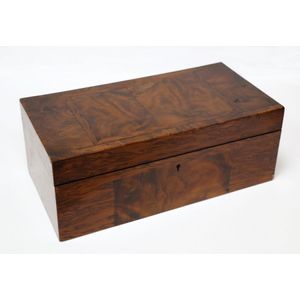Brazilian Rosewood Tea Caddy with Crystal Mixing Bowl
A Brazilian rosewood tea caddy, circa 1835 (2). A Brazilian rosewood tea caddy, circa 1835 of sarcophagus form, the domed rectangular lid opening to reveal an interior with two tea boxes flanking a central crystal mixing bowl, with tapering sides, brass lion mask and ring handles to either end, supported on bun feet (2) 20 cm high, 33 cm wide, 20 cm deep. Property from the Collection of Dame Nellie Melba GBE
You must be a subscriber, and be logged in to view price and dealer details.
Subscribe Now to view actual auction price for this item
When you subscribe, you have the option of setting the currency in which to display prices to $Au, $US, $NZ or Stg.
This item has been sold, and the description, image and price are for reference purposes only.
- Lion Mask - The lion mask has been used for centuries in various forms of art and design, including furniture, silver, and ceramics, and is usually y depicted as a stylized representation of the face of a lion, often with an open mouth and protruding tongue. and is often used as a handle, knob, or other decorative element.
In furniture design, lion masks were popular in the neoclassical and Empire styles of the late 18th and early 19th centuries. They were often used as decorative elements on the legs or arms of chairs, as well as on cabinet and drawer pulls. It was also used as a handle, knob, or other decorative element.
In silverware design, lion masks were often applied to tea and coffee pots, as well as on candlesticks, snuff boxes, and other small silver items. The lion mask was often used in combination with other neoclassical motifs, such as laurel wreaths or acanthus leaves, to create a sense of grandeur and classical elegance.
In ceramics, lion masks were often depicted in relief, and were sometimes used in combination with other decorative elements, such as garlands or swags. - Circa - A Latin term meaning 'about', often used in the antique trade to give an approximate date for the piece, usually considered to be five years on either side of the circa year. Thus, circa 1900 means the piece was made about 1900, probably between 1895 and 1905. The expression is sometimes abbreviated to c.1900.
- Rosewood - A dense timber that varies in shade to very light brown to almost black. When rosewood is cut and sanded the colour of the timber will turn black, and after polishing and exposure to daylight, the surface will gradually lighten over time to light brown with black streaks.
The name comes from the odour emanating from the timber when it is planed, sanded or cut.
Rosewood was very popular for use in Victorian furniture in the second half of the 19th century, and at that time most of the rosewood was imported from Brazil. However it also grows in India and Indonesia.
It is used in the sold for chairs and table legs, but for carcase furniture such as side cabinets and bookcases, and for table tops it is always used as a veneer.
This item has been included into following indexes:
Visually similar items

Mottled kauri New Zealand colonial deed box. Width 36.5 cm
Sold by
in
for
You can display prices in $Au, $US, $NZ or Stg.

An antique elm lift-top trunk, early 19th century. Height 38 cm, width 103 cm, depth 49 cm.
Sold by
in
for
You can display prices in $Au, $US, $NZ or Stg.

New Zealand colonial deeds box in rewarewa reserved on kauri
Sold by
in
for
You can display prices in $Au, $US, $NZ or Stg.

An Anglo-Indian satinwood tea caddy, circa 1840, 21.5 cm high, 23 cm wide, 16 cm deep
Sold by
in
for
You can display prices in $Au, $US, $NZ or Stg.
